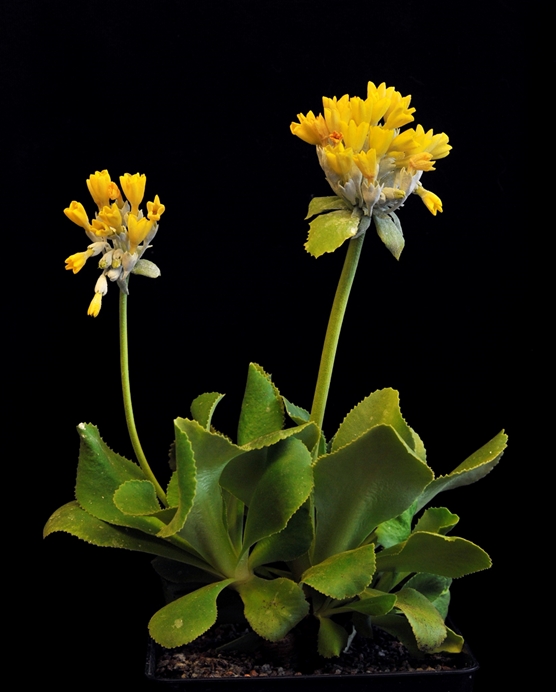The cultivation of Primula palinuri Petagna for ex situ conservation: lessons learned from the Royal Rotterdam Zoological and Botanical Gardens
DOI:
https://doi.org/10.24823/Sibbaldia.2024.2029Abstract
Primula palinuri Petagna is an endangered species endemic to a tiny coastal area in southern Italy. Investigating the possibility of growing and propagating this endangered species with ex situ actions should be encouraged, as this could provide a second line of security for rare plants by allowing specimens to be grown in the absence of natural environmental challenges. Currently, the Royal Rotterdam Zoological and Botanical Gardens (RRZBG) hold 31 accessions of P. palinuri, which represents an ex situ collection with potential value for conservation programmes. Over the years, horticulturists at RRZBG have created a solid protocol to produce viable seeds through hand-pollination techniques, thus allowing conservation programmes for this species to become more effective. In this article the cultivation of the species is described, including information on seed germination, general maintenance, cultivation to flowering stage and propagation from the resulting seeds.
References
ARONNE, G. (2017). Identification of bottlenecks in the plant life cycle for sustainable conservation of rare and endangered species. Frontiers in Ecology and Evolution, 5: 76. doi: https://doi.org/10.3389/fevo.2017.00076
ARONNE, G., BUONANNO, M. & DE MICCO, V. (2014). Reproducing under a warming climate: long winter flowering and extended flower longevity in the only Mediterranean and maritime Primula. Plant Biology, 17(2): 535–544. doi: https://doi.org/10.1111/plb.12239
BARMENTLO, S.H., MEIRMANS, P.G., LUIJTEN, S.H., TRIEST, L. & OOSTERMEIJER, J.G.B. (2018). Outbreeding depression and breeding system evolution in small, remnant populations of Primula vulgaris: consequences for genetic rescue. Conservation Genetics, 19(3): 545–554. doi: https://doi.org/10.1007/s10592-017-1031-x
BGCI PLANTSEARCH (2023). PlantSearch online database. Botanic Gardens Conservation International, Richmond. Available online: https://tools.bgci.org/plant_search.php (accessed 5 April 2024).
CASAZZA, G., GRANATO, L., MINUTO, L. & CONTRI, E. (2012). Polyploid evolution and Pleistocene glacial cycles: A case study from the alpine primrose Primula marginata (Primulaceae). BMC Evolutionary Biology, 12: 56. doi: https://doi.org/10.1186/1471-2148-12-56
CREMA, S., KADEREIT, J.W. & CRISTOFOLINI, G. (2013). Phylogenetic insights into Primula Sect. Auricula in the Apennine Peninsula. Flora Mediterranea, 23: 157–172. doi: https://doi.org/10.7320/FlMedit23.157
DE MICCO, V. & ARONNE, G. (2012). Occurrence of morphological and anatomical adaptive traits in young and adult plants of the rare Mediterranean cliff species Primula palinuri Petagna. Scientific World Journal, 471814. https://doi.org/doi: 10.1100/2012/471814
ENSSLIN, A., SANDNER, T.M. & MATTHIES, D. (2011). Consequences of ex situ cultivation of plants: Genetic diversity, fitness and adaptation of the monocarpic Cynoglossum officinale L. in botanic gardens. Biological Conservation, 144(1): 272–278. doi: https://doi.org/10.1016/j.biocon.2010.09.001
EUROPEAN ECONOMIC AREA (2023). EU conservation status of Primula palinuri Petagna. Available online: https://eunis.eea.europa.eu/species/178991#protected (accessed 5 April 2024).
GANGALE, C., UZUNOV, D. & CESCA, G. (2011). Primula palinuri. The IUCN Red List of Threatened Species 2011: e.T161810A5498316. Available online: www.iucnredlist.org/species/161810/5498316 (accessed 5 April 2024).
IUCN (2013). Guidelines for reintroductions and other conservation translocations. Version 1.0. IUCN Species Survival Commission. Available online: https://portals.iucn.org/library/efiles/documents/2013-009.pdf (accessed 5 April 2024).
MOUNCE, R., SMITH, P. & BROCKINGTON, S. (2017). Ex situ conservation of plant diversity in the world’s botanic gardens. Nature Plants, 3: 795–802. doi: https://doi.org/10.1038/s41477-017-0019-3
NAGEL, R., DURKA, W., BOSSDORF, O. & BUCHAROVA, A. (2019). Rapid evolution in native plants cultivated for ecological restoration: not a general pattern. Plant Biology, 21(3): 551–558. doi: https://doi.org/10.1111/plb.12901
OLDFIELD, S.F. (2009). Botanic gardens and the conservation of tree species. Trends in Plant Science, 14(11): 581–583. doi: https://doi.org/10.1016/j.tplants.2009.08.013
REDSTONE, S. & FOX, A. (2021). The biosecurity risks of seeds in a botanic garden context. Sibbaldia, 20: 147–162. doi: https://doi.org/10.24823/Sibbaldia.2021.341
RICHARDS, A.J. (2003). Primula. Timber Press, Portland, OR.
STRUMIA, S., BUONANNO, M., ARONNE, G., SANTO, A. & SANTANGELO, A. (2020). Monitoring of plant species and communities on coastal cliffs: is the use of unmanned aerial vehicles suitable? Diversity, 12(4): 149. doi: https://doi.org/10.3390/d12040149
ZHANG, L.B. & KADEREIT, J.W. (2004). Classification of Primula sect. Auricula (Primulaceae) based on two molecular data sets (ITS, AFLPs), morphology and geographical distribution. Botanical Journal of the Linnean Society, 146: 1–26. doi: https://doi.org/10.1111/j.1095-8339.2004.00301.x

Downloads
Published
Issue
Section
License
Copyright (c) 2024 Louwerens-Jan Nederlof, Giovanna Aronne, Sergio Mugnai

This work is licensed under a Creative Commons Attribution 4.0 International License.
Please read our Open Access, Copyright and Permissions policies for more information.





